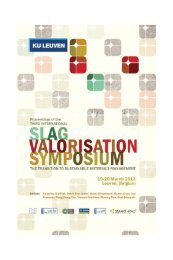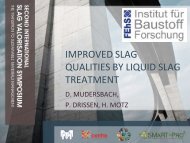International Slag Valorisation SymposiumLeuven6-7/4/2009 - Third ...
International Slag Valorisation SymposiumLeuven6-7/4/2009 - Third ...
International Slag Valorisation SymposiumLeuven6-7/4/2009 - Third ...
Create successful ePaper yourself
Turn your PDF publications into a flip-book with our unique Google optimized e-Paper software.
Steel production in 2007 amounted to 1.342 Gton and in 2008 to 1.3297 Gton.<br />
Anthropogenic emissions of GHGs, which amounted to 49 Gton of CO 2 equivalent<br />
worldwide in 2004, 1) are traditionally split among economic sectors, among which<br />
industry represented 19.4%. The Steel Industry represents 6 to 7% of global<br />
anthropogenic CO 2 emissions according to the IPCC, 1) but only 4-5% according to the<br />
IEA, 2) i.e. one fourth to one third of the whole industry sector. These estimates include<br />
direct emissions by the steel mills themselves and indirect ones, generated by the energy<br />
sector to produce the electricity that the mills consume. This accounting method leaves<br />
out a life-cycle presentation, where the benefits of using steel, in terms of CO 2<br />
emissions that can be allocated to using it, would be taken on board: this would account<br />
for avoided emissions at least an order of magnitude larger than the emissions of the<br />
steel mills. But in a traditional analysis, this scenario modeling of a society that uses<br />
steel, against an hypothetical one that would not, is usually not considered.<br />
The carbon dioxide intensity of the steel sector today is 1.9 t CO2/t crude steel. The Steel<br />
Industry comes out as a small emitter compared to the energy sector (25.9%), transport<br />
(13.1%), forestry (17.4%) or agriculture (13.5%). However, the CO2 stream is generated<br />
by a relatively small number of large emitters, each one spouting out between 1 and 10<br />
Mton per year.<br />
CO2 emissions of the Steel Sector<br />
Why does the Steel Industry generate CO2? There are two main reasons: on the one<br />
hand, energy is needed to produce steel, more often than not generated from fossil fuels,<br />
while on the other hand, reducing agents are necessary to produce steel from iron ores,<br />
the cheapest, most easily available reductant being the carbon of coal. Figure 1 shows<br />
the various production routes used today to make steel and their share in the world and<br />
in France. The Blast Furnace (BF) route produces steel from primary raw materials, i.e.<br />
iron ore and requires both energy and reducing agents in the form of coke and<br />
pulverised coal; it is called an Integrated Steel Mill. The Electric Arc Furnace (EAF)<br />
route produces steel from secondary raw materials, i.e. iron scrap, and needs mainly<br />
energy, in the form of electricity, along with some coal and oxygen. The DR route is<br />
based on ore and uses natural gas as the reducing agent and fuel, along with electricity<br />
for subsequent processing in an EAF. The carbon dioxide intensity of the three routes is<br />
respectively 1.97, 1.10 and 0.45 t CO2/t crude steel.<br />
1 st <strong>International</strong> <strong>Slag</strong> <strong>Valorisation</strong> Symposium│Leuven│6-7/4/<strong>2009</strong><br />
16







